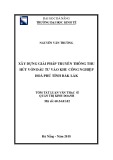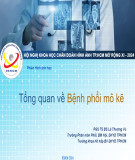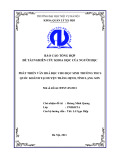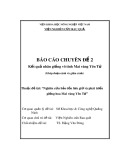
BioMed Central
Page 1 of 8
(page number not for citation purposes)
Journal of Translational Medicine
Open Access
Review
Human immunodeficiency virus and human papilloma virus - why
HPV-induced lesions do not spontaneously resolve and why
therapeutic vaccination can be successful
Sjoerd H van der Burg*1,2 and Joel M Palefsky1,2
Address: 1Department of Clinical Oncology, Leiden University Medical Center, Leiden, The Netherlands and 2Department of Medicine, University
of California, San Francisco, San Francisco, CA, USA
Email: Sjoerd H van der Burg* - shvdburg@lumc.nl; Joel M Palefsky - palefskyj@gcrc.ucsf.edu
* Corresponding author
Abstract
HIV and HPV can both cause chronic infections and are acquired during sexual contact. HIV
infection results in a progressive loss of CD4+ T cells that is associated with an increased
prevalence of HPV infections, type-specific persistence and an increase in HPV-associated
malignancies. On the one hand this illustrates the important role of HPV-specific CD4+ helper T-
cell immunity, on the other it shows the Achilles heel of the HPV-specific immune response. The
use of highly active antiretroviral therapy (HAART) results in a rapid reduction of HIV and a
reconstitution of systemic CD4+ T-cell levels. The use of HAART thus has the potential to raise
immunity to HPV but to the surprise of many, the incidence of HPV-induced diseases has increased
rather than declined since the introduction of HAART. Here, the knowledge on how HPV-induced
diseases develop in the face of a non-compromised immune system will be used to explain why the
effect of HAART on HPV-induced diseases is modest at best. Furthermore, exciting new data in
the field of therapeutic vaccines against HPV will be discussed as this may form a more durable and
clinically successful therapeutic approach for the treatment of HPV-induced high-grade lesions in
HIV-positive subjects on HAART.
Introduction
Human papilloma virus (HPV) is the most commonly
sexually transmitted agent worldwide. A high prevalence
of HPV has been reported especially among young sexu-
ally active individuals. Persistent infection with oncogenic
HPV types, in particular HPV16, are causally related to the
development of anogenital lesions like cervical intra-epi-
thelial neoplasia (CIN), vulvar intraepithelial neoplasia
(VIN) and anal intraepithelial neoplasia (AIN) as well as
their subsequent progression to invasive squamous cell
carcinoma [1-5]. While HPV infection is asymptomatic in
the great majority of immunocompetent individuals, a
small proportion of men and women fail to control viral
infection and develop HPV-related malignancies.
The incidence of cervical as well as anal precursor lesions
and cancer is markedly higher in HIV-positive men and
women [6-8] compared with HIV-negative men and
women. In men who have sex with men (MSM) the inci-
dence of AIN and anal cancer was already particularly
high and incidence rates are substantially elevated in the
population of HIV-positive MSM. Furthermore, the risk of
Published: 18 December 2009
Journal of Translational Medicine 2009, 7:108 doi:10.1186/1479-5876-7-108
Received: 5 November 2009
Accepted: 18 December 2009
This article is available from: http://www.translational-medicine.com/content/7/1/108
© 2009 Burg and Palefsky; licensee BioMed Central Ltd.
This is an Open Access article distributed under the terms of the Creative Commons Attribution License (http://creativecommons.org/licenses/by/2.0),
which permits unrestricted use, distribution, and reproduction in any medium, provided the original work is properly cited.

Journal of Translational Medicine 2009, 7:108 http://www.translational-medicine.com/content/7/1/108
Page 2 of 8
(page number not for citation purposes)
other HPV-associated cancers of the oropharynx, penis,
vagina, and vulva is also increased among persons with
AIDS [9]. The introduction of antiretroviral therapy in the
mid-nineties restored immune responses to several AIDS-
defining opportunistic infectious agents such as cytomeg-
alovirus and human herpes virus-8, as well as significantly
changed the prognosis and mortality rates of HIV-infected
subjects. However, the longer survival of highly active
antiretroviral therapy (HAART)-treated subjects led to a
high incidence and steady increase in HPV-related malig-
nancies both in women and men [7-11]. This counter-
intuitive observation of detecting more HPV-induced
malignancies after restoration of the immune system
requires an explanation, and the answer may be found in
studies on HPV-specific immunity in immune competent
individuals.
CD4+ T cells, the Achilles heel of HPV-specific
immunity
Epidemiological studies have shown a strikingly high
prevalence of oncogenic HPV types in the general popula-
tion [12-15]. For example the cumulative lifetime inci-
dence of HPV16 infection is estimated to be over 50%
[16]. In most healthy persons the immune system suc-
ceeds in eliminating oncogenic HPV types before malig-
nancies develop [13,17]. Natural history studies [18]
show that most (90%) low-grade cervical intraepithelial
neoplasia (CIN 1) can regress spontaneously and this is
attributed to the fact that many CIN 1 lesions are induced
by the low-risk non-oncogenic HPV types as well as the
development of HPV antigen-specific cellular immune
responses. At the time of spontaneous regression of HPV-
infected genital warts, the lesions are infiltrated with
CD8+ cytotoxic T-cells (CTL), CD4+ T-cells and macro-
phages [19]. This observation fits well with the general
notion that the protective immune response to chronic
viral infections is a polyfunctional type 1 response of both
CD4+ helper T cells and CD8+ cytotoxic T cells [20-24]. In
addition to their direct effects, virus-specific CD4+ T cells
are needed to sustain CD8+ effector T-cell responses as
well as to activate innate effector cells. Comprehensive
studies on HPV16-specific immunity have revealed that
HPV16-specific CD4+ T-cell responses and HPV16-spe-
cific CTL responses directed against the viral early antigens
E2, E6 and/or E7 are detected in peripheral blood mono-
nuclear cell (PBMC) cultures of the majority of healthy
individuals. In general, HPV-specific CD4+ T-cell immu-
nity comprises both Th1- (IFNγ) and Th2-producing (IL-
5) T cells reactive to a broad array of epitopes within these
antigens [25-30]. Moreover, these circulating HPV16-spe-
cific CD4+ and CD8+ T cells are able to migrate from the
circulation to the epithelium upon antigenic challenge in
healthy subjects [31]. These observations suggest that suc-
cessful defense against HPV16 infection is commonly
associated with the induction of a systemic effector T-cell
response against the viral early antigens. This notion is
sustained by our recent observation that the vaccine-
induced regression of HPV16-induced high-grade VIN
was associated with a strong and broad IFNγ-associated
CD4+ T-cell response against E6 and E7 [32].
Unfortunately, HIV infection results in a progressive loss
of CD4+ T cells. When one considers the type of immune
response needed to deal with chronic viral infections in
general, the frequent detection of HPV-specific CD4+ T-
cell reactivity in protected healthy individuals as well as
the association between HPV-specific CD4+ T cells and
regression of HPV-induced premalignant lesions, it
becomes clear why the loss of CD4+ T-cells is associated
with an increased prevalence of HPV infections, type-spe-
cific persistence and an increase of HPV-associated malig-
nancies [33]. On the one hand this illustrates the
important role of HPV-specific CD4+ helper T-cell immu-
nity, on the other it shows that HPV-specific CD4+ T-cell
immunity is the Achilles heel of protection against HPV-
induced disease.
Restoration of CD4+ T-cell immunity to
pathogens requires antigen exposure under
inflammatory conditions
HAART consists of an antiretroviral drug regimen which
combines inhibitors of the HIV reverse transcriptase and
protease. Depending on the HIV disease stage and the
level of HIV viral control over time, the use of HAART
results in an increase in the number of CD4+ T cells that
may reach (near) normal counts within 2-6 years [34]. Ini-
tially HAART induces a rapid increase in CD4+ T-cell
counts as a result of the redistribution of memory T cells
that had been sequestered in inflamed lymphoid tissues
that have come to rest as a result of a significant drop of
the HIV viral load when HIV is controlled. The second
phase is slower and thought to reflect the re-expansion of
naïve CD4+ T cells and re-diversification of the T-cell rep-
ertoire following the treatment of this chronic infection
[34].
The increase in CD4+ T-cell counts coincides with the
decrease in several of the AIDS-defining illnesses arising
from opportunistic infections and the detection of T-cell
responses against agents such as CMV [35], Candida,
Mycobacterium and Streptococcus [36,37]. This occurs a
few months after therapy has commenced and is thought
to arise after exposure to sufficient quantities of the tar-
geted antigens upon (re-)infection with these pathogens.
HIV-specific T cells are only detected at the time of a pri-
mary infection or when HAART is given before the onset
of CD4+ T cell depletion [34] but not in chronically-
infected HAART-treated patients [36,37]. However, Jansen
et al. observed an increase in HIV-specific CD4+ T-cell
proliferative capacity after 55 months of HAART [38].

Journal of Translational Medicine 2009, 7:108 http://www.translational-medicine.com/content/7/1/108
Page 3 of 8
(page number not for citation purposes)
These data indicate that chronic infection results in the
depletion of HIV-specific immunity - which sounds rea-
sonable as CD4+ T cells are a prime target of HIV - and
suggest that new thymic emigrants are only stimulated to
respond to HIV over time. The difference in the kinetics of
the cellular response to opportunistic pathogens and HIV
is best explained by a difference in the host's exposure to
antigenic stimuli. The rapid decline of HIV - and as such
the amount of HIV antigens which can be presented to the
immune system - following HAART is likely to result in
suboptimal stimulation of the immune system to HIV.
This notion is sustained by the observations that HIV-spe-
cific central and effector CD4+ and CD8+ memory T cell
populations rapidly disappear from the peripheral blood
of infected individuals under HAART [39] while re-expo-
sure of the immune system to HIV during structured ther-
apy interruption (STI) after one year of HAART results in
expansion of HIV-specific CD4+ and CD8+ T cells [40].
The important point here is that restoration of immunity
in HIV-infected patients on HAART to infectious agents
requires (re-)infection and exposure to sufficient amounts
of pathogen-derived antigens under inflammatory condi-
tions.
Failure to restore protective HPV-specific
immunity in HIV-positive patients on HAART
Thus far, there is no evidence showing that the oncogenic
behaviour of HPV is altered by HIV[41] and while HIV-
induced immunosuppression can be held accountable for
the increased incidence of precursor lesions it does not
explain why these lesions do not resolve when HAART is
given and immunosuppression is alleviated.
Some previous studies do report a positive effect of
HAART on the natural history of HPV-induced pre-malig-
nancies in HIV-infected subjects. A close look at the data
shows us that most of the effects noted are among patients
with low-grade lesions with response rates of ~35%
[42,43], which is still lower than what is observed in
immunocompetent individuals of whom ~60% clears a
low-grade CIN within 12 months [44]. Notably, 25% of
the HIV-infected low-grade CIN subjects on HAART still
progress to high-grade CIN [43] and HIV-infected patients
with high-grade CIN often do not show regression when
treated with HAART [43,45]. One should realize that in
many HIV-positive patients on HAART the HPV infections
and HPV-induced lesions are not newly acquired but
reflect persistence and/or recently reactivated prior infec-
tions of the HPV types detected despite an increase in
CD4+ T cell levels [8]. In a number of cases it may also
reflect new exposure [46]. The persistence of HPV and
HPV-induced lesions indicate that HPV-infection was not
counteracted in the first place and that the virus was
allowed to establish LSIL and/or HSIL lesions before the
capacity of the immune system to respond was restored.
So what happens with the HPV-specific immune response
in patients on HAART? It is hard to know as there are few
studies on the kinetics of HPV-specific immunity during
HAART. Fortunately, there is considerable knowledge on
HPV-specific immunity in immunocompetent individu-
als that allows us to understand why HAART cannot sim-
ply restore full protective immunity to HPV in HIV-
infected subjects.
Immunity to HPV-induced lesions in
immunocompetent individuals
In contrast to the opportunistic pathogens or HIV, HPV is
rather a stealthy virus as it causes minimal inflammation,
allowing it to persist at detectable levels for 12-18 months
in immunocompetent subjects [47]. From a teleologic
point of view this is necessary for HPV as it requires the
full cycle of keratinocyte differentiation to produce its
own viral particles and inflammatory signals may jeop-
ardize its capacity to replicate. Although much work is still
needed in this area, HPV seems to alter transcriptional
activity of the IFNβ and NFkB-pathways resulting in a
decreased ability of keratinocytes to produce the necessary
cytokines and chemokines to attract the adaptive immune
system [48-50]. The identification of HPV-induced low-
grade or high-grade lesions reflects molecular changes in
the normal program of epithelial cell differentiation that
occur following infection. Importantly, the timely expres-
sion of viral gene products and the linked production of
viral particles are progressively disturbed during neoplas-
tic progression [51]. In addition, the development of such
lesions is associated with a locally altered cytokine envi-
ronment with an increase in IL-10 and a decrease in proin-
flammatory cytokines [52-54]. The progression rate of
high-grade lesions of the cervix, vulva or anal region to
cancer in immunocompetent subjects is similar among
the different types of lesions (9-13%) [55-57], and regres-
sions are only occasionally observed.
A comparison of immune presentation of opportunistic
pathogens and HPV indicates that there is less inflamma-
tion and there are lower amounts of antigens available to
the immune system with HPV infection. One could com-
pare the presentation of HPV antigens in immunocompe-
tent subjects to that of HIV antigens in patients on
HAART, as in both cases the induction of detectable
immune responses may take a while. When HPV-induced
lesions develop, the production of viral antigens is
severely altered due to the loss of a productive infection.
Some viral antigens are not produced anymore (e.g. E2)
whereas others may increase in time (e.g. E7). Most
importantly antigen-presenting cells (APC) that are
present in the local region and whose normal role is to
ingest and present the viral antigens to T cells, are func-
tionally altered as these APC are exposed to an immuno-
suppressive environment and become tolerized [58]. As a

Journal of Translational Medicine 2009, 7:108 http://www.translational-medicine.com/content/7/1/108
Page 4 of 8
(page number not for citation purposes)
consequence the immune response to HPV is different in
patients with HPV-induced lesions when compared with
healthy individuals who do not have HPV-associated dis-
ease (see above).
In a large prospective study on the clinical course of low-
grade CIN we have studied HPV16-specific immunity in
relation to clinical outcome [59]. HPV16-specific IFNγ-
associated T-cell responses were detected in only half of
the patients with an HPV16+ low-grade CIN, and
responses were predominantly to HPV16 E2 and E6. Inter-
estingly, the presence of HPV16 E2-specific T-cell
responses correlated with absence of progression of
HPV16+ lesions but this was only a small group [59].
Thus the immune system clearly fails to activate CD4+
IFNγ-producing HPV-specific T cells in half of the immu-
nocompetent patients with low-grade CIN and only in a
minority of the subjects the immune response is strong
enough to induce regression.
The HPV-specific immune response in patients with high-
grade CIN lesions is even worse. The accumulated data
from a number of different studies on patients with
HPV16+ high-grade CIN revealed that HPV16-specific T-
cell responses were absent in the circulation of the major-
ity of patients who visit the clinic for treatment of an
HPV16+ high-grade lesion. Notably, the quality of the
immune response in those patients who did show
HPV16-specific reactivity was low in the sense that most
of the detected HPV16-specific T-cell responses did not
include secretion of pro-inflammatory cytokines such as
IFNγ. In the end, more than 75% of all patients with a
high-grade lesion failed to develop an HPV16-specific cel-
lular immune response which would remotely resemble
that of what was seen in healthy individuals [26,59-62].
Importantly, HPV16-specific T-cell reactivity was predom-
inantly found in patients returning to the clinic for repet-
itive treatment of a persistent or recurrent HPV16+ high-
grade CIN after initial destructive treatment [61]. This sug-
gests that the induction of HPV-specific reactivity in
patients with high-grade CIN requires sufficient exposure
to antigen (achieved by persistence/recurrence) as well as
inflammation such as is caused by destructive treatment.
Unfortunately, this is the case in only a minority of
women with high-grade CIN. Moreover, when the viral
antigens are presented it is usually in a suppressive envi-
ronment and as a result a non-beneficial HPV-specific
immune response develops that is unable to induce the
regression of an HPV-induced lesion. This notion is con-
sistent with our observation that high-grade CIN-infiltrat-
ing T-cell cultures can contain HPV16-specific regulatory
T-cells [61]. Thus if an HPV-specific immune is present in
patients with high-grade CIN it consists of T-cells that do
not produce IFNγ and sometimes even has a suppressive
signature. This type of immunity is in clear contrast with
that found in healthy individuals or patients in whom
their lesions regressed [25-27,32,63]. Aforementioned
data on HPV16-specific T-cell immunity in HIV-positive
patients on HAART are lacking but it would be safe to
assume that the response rate and type of HPV-specific
immune response in HIV-positive patients on HAART at
least is not better than that of immunocompetent patients
with low-grade or high-grade lesions.
Current literature indicates that HPV-induced lesions are
less likely to regress in immunocompetent [64] or HIV-
positive patients [65] when these lesions - being either
low-grade or high-grade - are induced by high-risk HPV
types as compared to low-risk HPV types. Moreover, the
accumulated data on HPV16-specific immunity in immu-
nocompetent patients clearly show that - even when the
immune system is not compromised - an established
high-risk HPV-induced lesion fails to trigger a functional
HPV-specific immune response. Considering that the
prevalence of HPV and HPV-associated disease are much
higher in HIV-infected men and women [8,66-69], it is
highly likely that the HPV-specific immune response in
patients on HAART will not be induced in most of them
or in some cases may resemble that of non-immunocom-
promised patients with lesions, i.e., does not confer pro-
tective immunity.
It is not fair to expect that HAART would lead to regression
of HPV-induced cancer as this also poses a general prob-
lem among immunocompetent patients with cancer. Fur-
thermore, cervical cancer is strongly associated with
failure to mount a strong HPV-specific type 1 T-helper and
cytotoxic T lymphocyte (CTL) response and the induction
of HPV-specific regulatory T cells [26,30,70-72]. Further-
more, CD8+ T cells may fail to migrate into the tumor cell
nests and when tumors are infiltrated by CD8 T cells it
coincides with infiltration by CD4+Foxp3+ regulatory T
cells. Moreover, half of the tumor-infiltrating T cells
express the programmed cell death receptor 1 as a sign of
T-cell exhaustion [73-75]. In addition, the loss of human
leukocyte antigens - which presents antigens to the T cells
- is often observed and has a clear negative impact on
patient survival [74].
Non-specific treatment is associated with high
recurrence rates
Screening and treatment options for CIN and cancer are
well established and consequently the incidence of cervi-
cal cancer in HIV-positive women has not increased fol-
lowing the implementation of HAART. There is, however,
a strong increase in the incidence of anal diseases in both
men and women [10]. Although cytological screening for
AIN - analogous to cervical screening - has been proposed
[76] this is not common practice. Similarly, treatment
guidelines for anal lesions are yet not available but the dif-

Journal of Translational Medicine 2009, 7:108 http://www.translational-medicine.com/content/7/1/108
Page 5 of 8
(page number not for citation purposes)
ferent strategies used so far fall into the categories of topi-
cal treatments, ablative treatments and immunotherapy.
In this they resemble current treatment options used for
the treatment of VIN in immunocompetent patients.
In a recent review of Kreuter et al. [77] an overview on the
response rates and recurrence rates associated with differ-
ent therapies for AIN is presented. In summary, ablative
treatments (e.g. surgery, infrared, laser therapy) in general
show a high response rate to treatment but also a high
recurrence rate (38-79%) within an average of 1-2 years. A
few studies indicated that topical treatment of patients
with AIN1-AIN3 with imiquimod may result in good clin-
ical responses in patients with good compliance [78-80],
albeit that these results have to be confirmed by others.
Notably, despite good initial results the recurrence rate of
26-29% is still high [78-80]. If the response of AIN to imi-
quimod is indeed that good, it resembles that seen for the
treatment of vulvar lesions in immunocompetent patients
[81] in whom clinical response was related to the presence
of weak IFNγ-producing HPV-specific T cells [63]. In view
of this association between HPV-immunity and therapy
response one may expect that also the responsiveness of
HIV-positive AIN patients on HAART to imiquimod is
related to the presence of HPV-specific immune
responses. This suggests that HPV-specific immunity may
also develop in patients with AIN on HAART albeit not
sufficiently to induce the regression of the lesion without
the help of a local induced of inflammation such as imiq-
uimod. To clarify this issue new studies are needed to
measure HPV-specific immunity in HAART-treated
patients.
HPV-specific therapeutic vaccination to treat
may now become an option
The clear link between HPV16 and cancers of the cervix,
vulva and anal region has prompted the development of
two types of vaccines. One type is focused on the preven-
tion of high-risk HPV-infection for which Franceschi and
De Vuyst argued that its success to prevent AIN and anal
cancer depends on the administration of the vaccine
before onset of sexual activity, its protective efficacy in
men as well as the willingness to expand vaccine programs
to both sexes [82]. The other type is a therapeutic vaccine
aiming at strengthening the HPV16-specific T-cell
response. In contrast to the natural context in which the
immune system is exposed to lesion-derived HPV anti-
gens, therapeutic vaccines can ensure the deliverance of
sufficient quantities of HPV antigens in a highly stimula-
tory context, and as such may be able to restore an ade-
quate HPV-specific immune response able to induce the
regression and clearance of HPV-induced lesions. Thus
far, two vaccines have been used to treat high-grade AIN
in HIV-negative men (ZYC101) or HIV-positive men
(SGN-00101). The vaccines were well-tolerated but did
not induce clinical responses higher than what would
spontaneously occur in these patient populations [83,84].
This result was not specific to AIN, since these vaccines
also were unable to induce regression of CIN in immuno-
competent patients[85,86].
Recently, a different type of vaccine consisting of overlap-
ping HPV16 E6 and E7 synthetic long peptides (HPV16-
SLP), was reported to induce strong and broad CD4+ T-
helper and CD8+ CTL responses in >95% of patients with
HPV16-induced cervical cancer [87,88]. The reason for its
strong immunogenicity has been extensively reviewed
[89]. A phase II clinical trial in which patients with VIN3
were treated with HPV16-SLP showed an objective clinical
response rate of 79% and complete and durable (>24
months) complete regression of the lesion in 47% of the
patients [32]. The spontaneous regression of these lesions
is <1.5% [90]. Furthermore, there was a clear correlation
with the strength of the IFNγ-producing HPV16-specific T-
cell response and clinical outcome [32]. Interestingly,
about half of the patients treated as well as half of the
patients with a complete regression had multifocal disease
some of which extended to the perianal region. Because of
the similarities between immunocompetent patients and
HIV-positive patients on HAART, in particular their
restored immune response to opportunistic infections,
these results offer hope for the treatment of HIV-positive
patients on HAART. There are, however, still many issues
to consider as we don't fully understand HPV-specific
immunity in HIV-positive patients on HAART yet. One of
these issues is the size of the lesion as in many cases HIV-
positive patients have large lesions. The relatively larger
VIN3 lesions were less likely to regress in immunocompe-
tent VIN3 patients with HPV16-SLP [32] and this is clearly
associated with an altered immune response (van der
Burg, unpublished), suggesting that if one would like to
have a chance to be successful one should start treatment
as soon as patients receive HAART and/or while lesions
are limited in size. One could even imagine vaccinating
patients showing only the signs of an HPV16 infection
with HPV16-SLP if significant reduction in development
of HPV16-related disease can be demonstrated in prospec-
tive studies.
Abbreviations
AIN: anal intraepithelial neoplasia; APC: antigen present-
ing cell; CIN: cervical intra-epithelial neoplasia; CTL: cyto-
toxic T lymphocyte; HAART: highly active antiretroviral
therapy; HIV: Human Immunodeficiency Virus; HPV:
Human Papilloma Virus; IFN: interferon; SLP: synthetic
long peptides; VIN: vulvar intraepithelial neoplasia.
Competing interests
SHvdB in an employee of the Leiden University Medical
Center (LUMC), which holds a patent on the use of syn-




![PET/CT trong ung thư phổi: Báo cáo [Năm]](https://cdn.tailieu.vn/images/document/thumbnail/2024/20240705/sanhobien01/135x160/8121720150427.jpg)





















